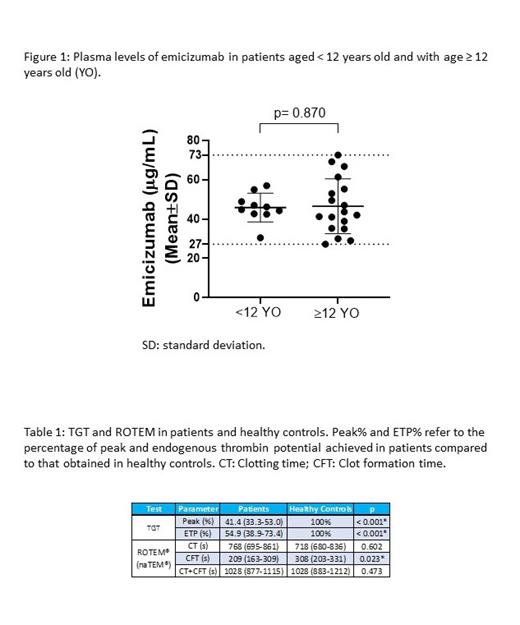Introduction: Emicizumab has improved the management of patients with hemophilia A. However, few real-world data are available on drug plasma levels and their correspondence with global hemostatic capacity (GHC) and annualized spontaneous joint bleeding rate (ASJBR).
Aims: Evaluation of the correlation between emicizumab plasma levels, GHC and ASJBR in patients on emicizumab prophylaxis.
Methods: Multicenter, observational and cross-sectional study was performed in 4 Spanish hospitals. Emicizumab plasma levels and thrombin generation capacity (TGT, Genesia ®, Stago ®) of patients on emicizumab prophylaxis were determined in a central laboratory. Kinetics of clot formation was evaluated by rotational thromboelastometry (ROTEM ®, naTEM ® test, Werfen ®) in one center. Time on emicizumab prophylaxis and the number of spontaneous joint bleeds (SJB) was collected retrospectively using the clinical history. Results are expressed as median (25 th-75 th percentiles) or mean ± standard deviation depending on data distribution. A p-value < 0.05 was considered statistically significant.
Results: Twenty-eight patients were included: 18 aged ≥12 years (age= 20.1 [14.7-38.9] years old) (group 1) and 10 patients aged <12 years (age= 6.1 [3.2-8.9] years old) (group 2) (p< 0.001). Globally, emicizumab levels were 46.3 ± 11.9 mcg/mL and similar between both groups: 45.2 ± 13.1 mcg/mL (group 1) and 45.9 ± 7.3 mcg/mL (group 2) (p=0.870) (Figure 1). No correlation was detected between emicizumab levels and TGT or ROTEM ®. Compared with healthy controls, patients presented lower values of thrombin generation: Peak (% compared to controls) = 41.4 (33.3-53.0) % and endogenous thrombin potential (ETP%) = 54.9 (38.9-73.4) %. However, on the contrary, ROTEM ® showed a similar procoagulant profile (example: CT and CT+CFT; p>0.05) or even higher (example: lower CFT values in patients; p= 0.023) compared to healthy subjects (Table 1). Throughout a follow-up period of 57.0 (32.3-102.3) weeks, none of the patients presented SJB (ASJBR =0).
Conclusions: Emicizumab treatment provided excellent protection to patients throughout the study period. The wide interpatient variation on emicizumab plasma levels does not appear to have an impact on the development of SJB. TGT and ROTEM ® showed contradictory results: TGT describes lower thrombin generation capacity in patients compared to healthy controls, while ROTEM ® showed a similar or even higher procoagulant function in patients. Additional studies are required to explain these findings and their clinical significance.
Disclosures
No relevant conflicts of interest to declare.


This feature is available to Subscribers Only
Sign In or Create an Account Close Modal